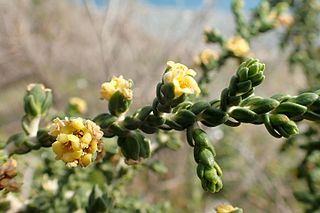
The Thymelaeaceae are a cosmopolitan family of flowering plants composed of 50 genera and 898 species. It was established in 1789 by Antoine Laurent de Jussieu. The Thymelaeaceae are mostly trees and shrubs, with a few vines and herbaceous plants.

Wikstroemia is a genus of 55-70 species of flowering shrubs and small trees in the mezereon family, Thymelaeaceae. Hawaiian species are known by the common name ‘ākia.

Wikstroemia indica, also known as tie bush, Indian stringbush, bootlace bush, or small-leaf salago is a small shrub with glossy leaves, small greenish-yellow flowers and toxic red fruits. It grows in forests and on rocky, shrubby slopes in central and southeastern China, Vietnam, India, Australia and the Philippines.
Wikstroemia taiwanensis is a shrub in the family Thymelaeaceae.
Wikstroemia trichotoma is a shrub in the family Thymelaeaceae. It is evergreen, and is found in eastern Asia, specifically Anhui, Guangdong, Guangxi, Hunan, Jiangxi, and Zhejiang.
Wikstroemia techinensis is a shrub in the family Thymelaeaceae. It is found in China, specifically Yunnan.
Wikstroemia stenophylla is a shrub in the family Thymelaeaceae. It is evergreen, and is found in China, specifically Sichuan.
Wikstroemia alternifolia is a shrub, of the family Thymelaeaceae. It is native to China, specifically Gansu and northern Sichuan.
Wikstroemia angustifolia is a shrub in the family Thymelaeaceae. It is native to China, specifically western Hubei, eastern Sichuan, and southern Shanxi.
Wikstroemia elliptica is a shrub, of the family Thymelaeaceae. It is native to Guam and Micronesia.

Wikstroemia monnula is a shrub in the family Thymelaeaceae. It is native to southern Anhui, Jiangxi, Guangdong, Guangxi, Guizhou, Hunan, and Zhejiang.
Wikstroemia mononectaria is a shrub in the family Thymelaeaceae. It is native to Taiwan.
Wikstroemia liangii is a shrub, of the family Thymelaeaceae. It is native to China, specifically Hainan.
Wikstroemia ligustrina is a shrub, of the family Thymelaeaceae. It is native to China, specifically Hebei, Shaanxi, Shanxi, Sichuan, and Yunnan.
Wikstroemia micrantha is a shrub in the family Thymelaeaceae. It is native to China, specifically Gansu, Guangdong, Guanxi, Guizhou, Hubei, Hunan, Shanxi, Sichuan, and Yunnan.
Wikstroemia parviflora is a shrub in the family Thymelaeaceae. It is native to China, specifically Gansu.
Wikstroemia paxiana is a shrub in the family Thymelaeaceae. It is native to China, specifically Sichuan.
Wikstroemia nutans is a shrub in the family Thymelaeaceae. It is native to Taiwan and China, specifically Fujian, Guangxi, Hainan, Hunan, Jiangxi, and Guangdong.

Wikstroemia monticola, the montane false ohelo, is a small tree, of the family Thymelaeaceae. It is endemic to Hawaii, specifically Maui.
Wikstroemia hanalei, the lavafield false ohelo, is a shrub, of the family Thymelaeaceae. It is native to the Hawaiian Islands, specifically Kauai.



